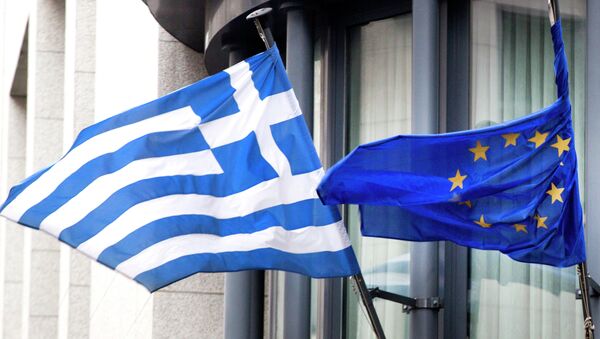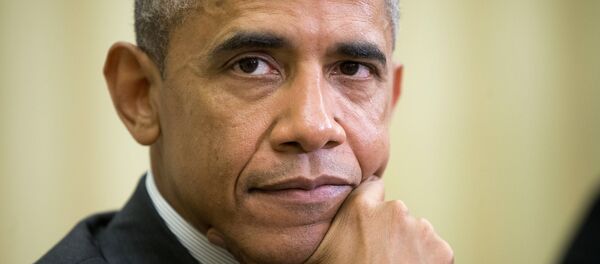Previous rounds of talks between Greece and its three main creditors – the International Monetary Fund (IMF), the Eurozone nations and the European Central Bank (ECB) — on the settlement of Athens' multibillion-dollar debt failed to bring results.
On Friday, President of the European Council Donald Tusk said that Saturday ministerial talks on Greece are expected to yield an agreement between Athens and its creditors.
2010 Bailout Loan to Greece
Greece’s aggregate debt exceeded 300 billion euros ($335 billion). In 2009 alone, the country borrowed about 80 billion euro ($89.3 billion) or 30 percent of its GDP.
On April 23, 2010, Greece officially asked the European Union and the IMF for financial aid, as the country was unable to manage its debts on its own.
Its budget deficit stood at 13.6 percent of GDP, a record for the Eurozone.
On May 2, 2010, at an emergency meeting in Brussels, finance ministers of 16 Eurozone countries approved a 110 billion euro ($122.8 billion) EU-IMF financial aid package for Greece, with 80 billion euro ($89.3 billion) pledged by the European Union, including about 22 billion euro ($24.5 billion) by Germany, the largest EU economy. It was agreed that the loans by Eurozone member countries would be bilateral.
The IMF and the European Union provided aid to Greece for five years, with a preferential five-percent interest rate for three and a half year loans and their subsequent repayments in 2014 and 2015.
In March 2011, the EU authorities decided to extend the repayment term for Greece to seven years and cut the interest rate by one percentage point.
The loans were provided to Greece in tranches. Every quarter, before approving the next tranche, the creditors' mission visited Athens to assess the government’s progress in carrying out a belt-tightening program. Expert findings were used as a basis for the Eurogroup (Eurozone finance ministers) and the IMF to decide on issuing a loan.
Greece's Austerity Measures in Return for Financial Aid
In exchange for financial aid, Greece had to implement austerity measures, targeting a number of macroeconomic indicators. The main condition was cutting the budget deficit.
The deficit was reduced by cutting government spending, including wages and pensions, as well as by slightly increasing tax revenues.
In mid-2011, the country’s authorities adopted an additional plan to cut spending by 28 billion euro ($31.2 billion) by the end of 2015, and significantly increased the privatization plan target to 50 billion euros ($55.8 billion). The implementation of austerity measures and the privatization of a number of state enterprises were accompanied by strikes and mass demonstrations in 2010.
Greece has achieved some success in cutting government spending and the budget deficit since the spring of 2010, but that led to a decline in GDP and a rise in the debt-to-GDP ratio around 190 percent. Furthermore, it was unable to return to long- and mid-term borrowing markets, which necessitated a second bailout package.
Extension of Rescue Package for Greece
The emergency summit of Eurozone leaders on July 21, 2011, approved a 160 billion euro ($178.6 billion) rescue package for Greece.
Higher interest rates were offered for bond swaps with a discount — 80 percent of face value. This plan provided for the cancellation of about 21 percent of Greek debts by private investors. However, the process of getting private investors "voluntarily involved" dragged on, while the worsening economic situation in Greece showed that the scope of debt cancellation had to be increased.
In February 2012, international creditors from the European Central Bank, the Eurozone nations and the IMF agreed to provide a second financial bailout package to Greece of 130 billion euro ($145 billion).
Furthermore, an agreement was reached with private investors for $100 billion euro ($111.5 billion) of the country’s debt on their balance sheets to be written off.
The loan agreement with the European Union provided for serious cuts in the country’s budget spending.
In the next four years Greece was to dismiss 150,000 civil servants while the country’s unemployment was over 20 percent, or 1 million, and GDP went down by 6.5 percent in 2011.
In July 2013, the Greek parliament approved further austerity measures, including, in addition to dismissals, a reduction of the budget deficit and changes in taxation, municipal services and the public education system.
The government's policy prompted thousands of Greeks, including teachers, school security staff, municipal police officers, local government employees and unemployed, to take to the streets across the country.
Latest Bailout Program Expires June 30
On February 20, the Eurogroup agreed to extend the loan program for Greece by another four months in exchange for further reforms. Greece pledged to move toward EU banking, tax and other regulations. The rescue plan was extended until June 30.
Under the two financial aid programs, Greece has received 240 billion euros ($270 billion) from its creditors, while its debt has exceeded 320 billion ($350 billion), which it is unable to tackle.










